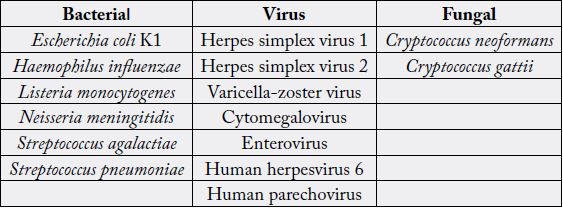Biography
Interests
Marta Valentim
Department of Internal Medicine, Hospital Distrital de Santarém, Portugal
*Correspondence to: Dr. Marta Valentim, Department of Internal Medicine, Hospital Distrital de Santarém, Portugal.
Copyright © 2018 Dr. Marta Valentim. This is an open access article distributed under the Creative Commons Attribution License, which permits unrestricted use, distribution, and reproduction in any medium, provided the original work is properly cited.
Abbreviations (if used)
ME: Meningitis/Encephalitis
CSF: Cerebrospinal fluid
FDA: Food and Drug Administration
HIV: human immunodeficiency virus
Introduction
Meningitis/Encephalitis (ME) is a life-threatening entity, hence a rapid diagnosis and treatment is required
to minimize the morbidity and mortality [1]. In United States there are approximately 4.100 cases of bacterial
meningitis and 20.000 of encephalitis per year, with 12% and 7% of mortality associated, respectively [1].
Nowadays we have several diagnostic procedures for identify different microorganisms in the cerebrospinal fluid (CSF) responsible for ME: the gram stain (the current gold standard), the culture, the antigen detection and the different molecular methods [1]. All these methods can be useful to achieve the correct microbiological diagnostic, but there are two main problems common to all of them: first the lack of sensitivity and specificity, and second, it takes time to get the results, in case the test achieve to detect the microorganism responsible for the ME [1].
The FilmArray ME Panel (BioFire, Salt Lake City, UT) were approval by Food and Drug Administration (FDA) in 2015 [2]. It has the capacity to detect multiple pathogens simultaneously. The results are obtained in one hour1, using about 200μL of CSF sample obtained by lumbar puncture [3].
Panel Targets
The FilmArray ME Panel was designed to detect the most common pathogens that cause communityacquired
or perinatally CNS infections [1], and also pathogens prevalent in immunocompromised patients
[3] (Table 1).

Pros
Analyzing the advantages of using this recent approved method, it is clear that the diagnostic speed is a huge
improvement over other methods that we currently have, since it will allow us to identify the etiology and
beginning an early and adequate treatment [3]. It is described in the literature that this method allows the
detection of the microorganism responsible for EM, up to 22.9% in cases whose CSF cultures have been
negative [2].
Another advantage associated with the use of FilmArray is the ease in the diagnostic identification of viral etiologies, which are generally difficult to obtain accurate and fast results by using other methods [2]. The widespread use of this technique will allow the suitability in the management, prescription and suspension, of the antibiotic therapy [3].
It is described that in the pediatric population it was possible to discontinue the antibiotic treatment during the first 24 hours, in 41.7% of the patients with positivity in the FilmArray for viral agents [3,4].
The relevance of the constant emergence of new diagnostic techniques is none other than the contribution, together with other tests and clinical manifestations, of adequate decision-making in specific cases by the clinical team [3,5].
Associated with a compatible clinic this panel has increased the detection of rare microbiological etiologies of ME [3]. Another positive point, is that it can helps in the diagnosis of specific subpopulations such as pediatrics or patients infected with the human immunodeficiency virus (HIV) where the immune reconstitution inflammatory syndrome sometimes makes it difficult to differentiate it from CNS infections [6].
Finally, we should point out that the economic impact of the implementation of these technique in the daily practise it is barely described or studies performed. Soucek et al. perform a cost-effective study about the implementation of the FilmArray in a community hospital, in which they conclude that it would be justified the used from the second year, thinking about the costs reduction of the hospital stay, the use of ant biotherapy or the costs associated with morbidity/mortality [3,7].
Cons
The mainly points against the use of the FilmArray focus on that these technique can never replace other
diagnostic methods; cause of the design it currently presents, it does not allow the detection of all the
microorganisms responsible for ME [2].
Furthermore, despite the lack of literature in these area, some studies as well as sporadic case reports agree with the fact, that the results obtained by FilmArray can delays and contribuited to errors in the definitive diagnosis, due to false-positive [8] and false-negative [3] results. Taking into account how the technique is performed, it is related with a high risk of contamination of the sample which would increase the falsepositive results. A clinical trial showed a high number of false positives secondary to contamination by Streptococcus pneumoniae [1,3].
The main problem with false-positive results are the delay to achieve the real diagnosis and the increase in the number of errors committed, as well as the deterioration in the patients prognosis [3,8].
Although only an article talks about the cost-effectiveness of the implementation of this procedure, the costs associated with the use are high [3], being necessary an infrastructure adapted to perform the technique with the greatest rigor possible, as well as trained staff and specific protocols for it implementation [3].
Conflicts of Interests
The authors declare that they have no competing interests.
Bibliography

Hi!
We're here to answer your questions!
Send us a message via Whatsapp, and we'll reply the moment we're available!